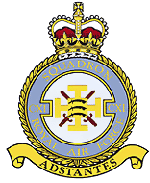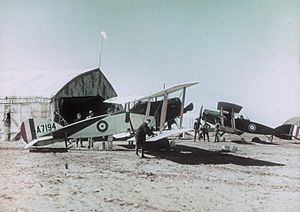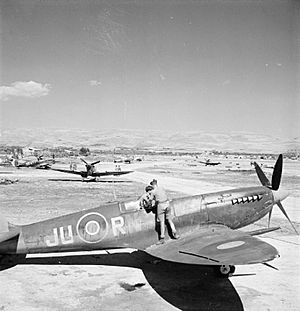No. 111 Squadron RAF facts for kids
Quick facts for kids No. 111 Squadron RAF |
|
|---|---|

No. 111 Squadron badge
|
|
| Active | 1 August 1917 – 1 April 1918 (RFC) 1 April 1918 – 1 February 1920 (RAF)< 1 October 1923 – 12 May 1947 2 December 1953 – 30 September 1974 1 October 1974 – 22 March 2011 |
| Country | |
| Branch | |
| Nickname(s) | 'Treble One' 'Tremblers' |
| Motto(s) | Latin: Adstantes ("Standing by") |
| Battle honours | Palestine 1917–1918*, Megiddo, Home Defence 1940–1942*, France and Low Countries 1940, Dunkirk*, Battle of Britain 1940*, Fortress Europe 1941–1942*, Dieppe, North Africa 1942–1943*, Sicily 1943, Italy 1943–1945*, Salerno, Anzio and Nettuno, Gustav Line, France and Germany 1944*. Honours marked with an asterisk are those emblazoned on the Squadron Standard |
| Insignia | |
| Squadron Badge | In front of two swords in saltire a cross potent quadrat charged with three seaxes fesswise in pale |
| Squadron Roundel | |
| Squadron Codes | TM (Apr 1939 – Sep 1939) JU (Sep 1939 – May 1947) B (Carried on Phantoms) H (Carried on Tornados) |
Number 111 (Fighter) Squadron, also known as No. CXI (F) Squadron and nicknamed Treble One, was a famous squadron of the Royal Air Force (RAF). A squadron is a group of military aircraft and their pilots. This squadron was first formed in 1917 in the Middle East. It was part of the Royal Flying Corps (RFC), which was the UK's air force before the RAF was created.
After the First World War, the squadron stayed in the Middle East until 1920. It was then renamed as No. 14 Squadron. But don't worry, No. 111 Squadron was brought back to life in 1923!
During World War II in 1940, Treble One played a very important role in the Battle of Britain. Later, it moved to the Mediterranean Sea area. There, it helped in the fighting in North Africa, Sicily, and Italy. After the war, the squadron was temporarily stopped. But it started up again in 1953, this time flying fast jet planes.
No. 111 Squadron became famous for its amazing aerobatic display team called the Black Arrows. They flew Hawker Hunter jets and put on incredible air shows. Later, they flew English Electric Lightning interceptor jets. In 1975, the squadron moved to Scotland. They started flying Phantom jets there. From 1990, they flew the Panavia Tornado F3 for air defence. The squadron was finally disbanded in March 2011. This marked the end of the Tornado F3's service in the RAF.
Contents
History of No. 111 Squadron
First World War Adventures
No. 111 Squadron of the Royal Flying Corps started on 1 August 1917. This happened in a place called Deir el-Balah in Palestine. It was the first special fighter squadron in that area. Its main job was to stop enemy planes from flying over and spying. They also challenged German fighter planes near Suez.
In September, they got Bristol F.2 Fighter planes. One of these planes achieved the squadron's first air victory on 8 October. By October 1917, the squadron also started getting Royal Aircraft Factory S.E.5a planes. In December, No. 111 Squadron was based at Julis.
In February 1918, they gave their Bristol Fighters to No. 1 Squadron, Australian Flying Corps. This meant No. 111 Squadron now only had single-seat fighter planes. In September 1918, Treble One took part in the Battle of Megiddo. Their mission was to attack the German airfield at Jenin. By the end of the war in the Middle East in October, No. 111 Squadron had shot down 44 enemy aircraft. They also forced 13 others to land. They only lost two pilots in combat. The squadron had four "flying aces" – pilots who shot down five or more enemy planes.
Between the World Wars
After the First World War, Treble One moved to Egypt. Then, on 6 February 1919, they went to Ramla in Palestine. They were flying Bristol Fighters again. On 1 February 1920, the squadron was renamed No. 14 Squadron.
But No. 111 Squadron was reformed on 1 October 1923. This happened at RAF Duxford. They first flew six Gloster Grebe fighters. These were the first Grebe planes used by the RAF. Later, they got Sopwith Snipes and Armstrong Whitworth Siskins. By January 1925, they were fully equipped with Siskins.
The squadron's job was to defend London. In 1931, they replaced their Siskins with Bristol Bulldogs. In July 1934, they moved to RAF Northolt. They then got Gloster Gauntlets in 1936. A very important moment came in January 1938. No. 111 Squadron became the very first squadron to fly the famous Hawker Hurricane fighter plane.
Second World War Battles
1939–1940: Defending Britain
When the war started, No. 111 (Fighter) Squadron was at RAF Northolt. In October 1939, they moved north to RAF Acklington. On 29 November, they got their first victory when a pilot shot down a German Heinkel He 111 bomber. In December 1939, Treble One moved even further north to RAF Drem. Their job was to protect the Royal Navy ships at Scapa Flow.
By May 1940, the squadron was back south at RAF Northolt. This was because Germany had invaded France. Treble One flew important defence missions during the Dunkirk evacuation. This was when many Allied soldiers were rescued from France.
No. 111 (Fighter) Squadron played a big part in the Battle of Britain. They were based at RAF Croydon. They were known for trying a risky new tactic: attacking German bomber groups head-on. This was very brave but also led to heavy losses. In September 1940, after losing many planes in August, they moved back north to RAF Drem. During this time, they claimed to have shot down 47 enemy aircraft. They lost 18 of their own Hurricane planes.
1941–1945: Fighting in the Mediterranean
In April 1941, the squadron got new planes: the famous Supermarine Spitfires. In November, Treble One moved to RAF Gibraltar. From there, they supported Operation Torch, which was the invasion of North Africa. In June 1943, they moved to Malta. This was to help with Operation Husky, the invasion of Sicily.
No. 111 (F) Squadron then moved through Italy as the Allied ground forces advanced. They stayed there until the war ended. After the war, they moved to Austria. The squadron was disbanded in May 1947. During the war, they claimed to have shot down 269 enemy aircraft. This made them one of the top RAF squadrons for victories.
The Cold War Era
The squadron was not active again until 2 December 1953. At RAF North Weald, they received Gloster Meteor F.8s jets. Soon, these Meteors were replaced with Hawker Hunters. Treble One then moved to RAF Wattisham.
They became internationally famous with their 'Black Arrows' aerobatic display team. They used the Hawker Hunter jets and performed amazing stunts in the sky. This was under the command of Squadron Leader Roger Topp.
In 1962, the squadron received the English Electric Lightning fighter jet. They flew these powerful jets for 12 years. In 1965, they were chosen to perform a special display with the Red Arrows at the Paris Air Show. This was a huge achievement. In 1974, the squadron moved from RAF Wattisham. They then got McDonnell Douglas Phantom FGR.2 jets at RAF Coningsby. On 3 November 1975, they moved north to RAF Leuchars in Scotland.
Tornado F.3 (1990–2011)
In 1990, the squadron started flying the Tornado F.3 jet. While at Leuchars, No. 111 (F) Squadron had an important job called Quick Reaction Alert (QRA). This meant they had to keep planes ready to take off very quickly. Their mission was to intercept, identify, and if needed, stop any hostile aircraft coming near UK airspace.
The squadron was involved in several operations. These included Operation Deny Flight and Operation Deliberate Force over Bosnia. They also took part in Operations Bolton and Resinate in the Middle East. They regularly joined in big Air Defence exercises, both in the UK and other countries.
Under Wing Commander Rob Birch, No. 111 (Fighter) Squadron was part of Operation Telic. They formed a major part of the Tornado F3 Wing at Prince Sultan Air Base in Saudi Arabia.
After No. 43 Squadron was disbanded in July 2009, Treble One was the only RAF unit still flying the Tornado F3. The squadron was finally disbanded at RAF Leuchars on 22 March 2011. This marked the end of the Tornado F3's service in the RAF.
Aircraft operated by No. 111 Squadron
Here are some of the different aircraft that No. 111 Squadron flew throughout its history:
- Bristol Scout (Aug 1917–Oct 1917)
- Royal Aircraft Factory B.E.2e (Aug 1917–Oct 1917)
- Bristol M.1e (Aug 1917–Jan 1918)
- de Havilland DH.2 (Aug 1917–Dec 1917)
- Vickers F.B.19 (Aug 1917–Jan 1918)
- Bristol F.2B Fighter (Sep 1917–Feb 1918)
- Royal Aircraft Factory S.E.5a (Oct 1917–Feb 1919)
- Nieuport 17 (Jan 1918–July 1918)
- Nieuport 23 (Jan 1918–July 1918)
- Nieuport 24 (Jan 1918–July 1918)
- Bristol F.2B Fighter (Feb 1919–Feb 1920)
- Gloster Grebe Mk.II (Oct 1923–Jan 1925)
- Sopwith Snipe (Apr 1924–Jan 1925)
- Armstrong Whitworth Siskin Mk.III (June 1924–Nov 1926)
- Armstrong Whitworth Siskin Mk.IIIa (Sep 1926–Feb 1931)
- Bristol Bulldog Mk.IIa (Jan 1931–June 1936)
- Gloster Gauntlet Mk.II (May 1936–Feb 1938)
- Hawker Hurricane Mk.I (Jan 1938–Apr 1941)
- Hawker Hurricane Mk.IIa (Mar 1941–May 1941)
- Supermarine Spitfire Mk.I (Apr 1941– May 1941)
- Supermarine Spitfire Mk.IIa (May 1941– Sep 1941)
- Supermarine Spitfire Mk.Vb (Aug 1941 – Oct 1941)
- Supermarine Spitfire Mk.IXe (June 1943 – May 1947)
- Gloster Meteor F.8 (Dec 1953–June 1955)
- Hawker Hunter F.4 (June 1955–Nov 1956)
- Hawker Hunter F.6 (Nov 1956–Apr 1961)
- English Electric Lightning F Mk 1A (Apr 1961–Dec 1964)
- English Electric Lightning F Mk 3 (Dec 1964–Sep 1974)
- English Electric Lightning F Mk 6 (Aug 1973–Sep 1974)
- McDonnell Douglas Phantom FGR.2 (Oct 1974–July 1979)
- McDonnell Douglas Phantom FG.1 (Jan 1978–Jan 1990)
- Panavia Tornado F.3 (June 1990–Mar 2011)
See also
- List of Royal Air Force aircraft squadrons





